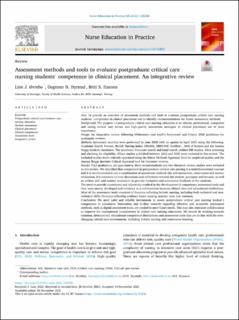| dc.identifier.citation | Øvrebø, L.J., Dyrstad, D.N., Hansen, B.S. (2022) Assessment methods and tools to evaluate postgraduate critical care nursing students' competence in clinical placement. An integrative review. Nurse Education in Practice, 58, 103258 | |
| dc.description.abstract | Aim
To provide an overview of assessment methods and tools to evaluate postgraduate critical care nursing students’ competence in clinical placement and to identify recommendations for future assessment methods.
Background
The purpose of postgraduate critical care nursing education is to educate professional, competent and caring critical care nurses and high-quality assessment strategies in clinical placement are of most importance.
Design
An integrative review following Whittemore and Knafl’s framework and Prisma 2020 guidelines for systematic reviews.
Methods
Systematic searches were performed in June 2020 with an update in April 2021 using the following: Academic Search Premier, British Nursing Index, CINAHL, MEDLINE, SveMed+, Web of Science and the Joanna Briggs Institute databases. The systematic literature search and hand search yielded 380 studies. After screening and checking for eligibility, fifteen studies published between 2005 and 2020 were included in this review. The included studies were critically appraised using the Mixed Methods Appraisal Tool for empirical studies and the Joanna Briggs Institute Critical Appraisal tool for literature reviews.
Results
Four qualitative, six quantitative, three mixed-methods and two literature review studies were included in this review. We identified that competence in postgraduate critical care nursing is a multidimensional concept and it is recommended to use a combination of assessment methods like self-assessment, observation and mentor evaluation. It is necessary to have discussions and reflections between the student, preceptor and lecturer, as well as written self- and mentor evaluation to provide formative and summative feedback to the students.
The need to provide consistency and objectivity resulted in the development of competency assessment tools and they were mostly developed and validated as a collaboration between clinical sites and educational institutions. Most of the assessment tools consisted of domains reflecting holistic nursing, including both technical and non-technical skills. Domains reflecting evidence-based nursing practice were less common.
Conclusions
We need valid and reliable instruments to assess postgraduate critical care nursing student’s competence in placement. Innovation and further research regarding effective and accessible assessment methods, such as digital assessment tools, are needed to meet future needs. This may also stimulate collaboration to improve the international inconsistency in critical care nursing educations. We should be working towards common, international educational competence descriptions and assessment tools that are in line with the ever-changing critical care environment, including holistic nursing and continuous learning. | |
